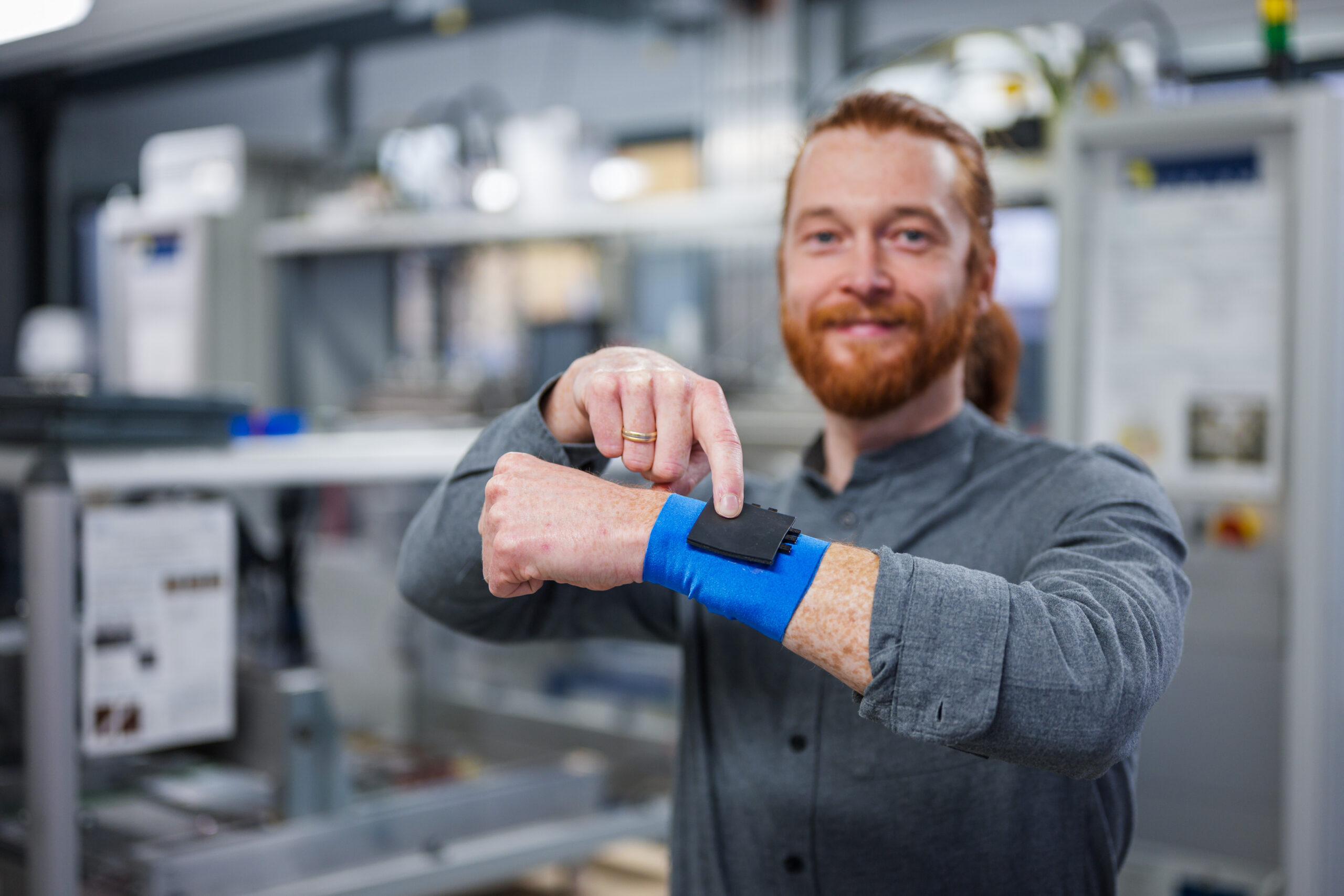Clothes transmit virtual touches to the skin, displays confirm inputs emphatically, even loudspeakers are becoming ultra-light: the thin silicone film that makes all this possible moves as desired, vibrates, taps, pushes or pulls. All with electrical voltage. The research teams of Professors Stefan Seelecke, Paul Motzki (Saarland University) and John Heppe (htw saar) will be demonstrating how they make their smart film drives at the Centre for Mechatronics and Automation Technology (Zema) even more efficient, stable, sensitive and fast at the Hannover Messe: 31 March to 4 April, Hall 2, Saarland stand B10.
Saarbrücken/Germany, March 27, 2025 The film is almost as thin as cling film and a real jack-of-all-trades. The team led by Professors Stefan Seelecke and Paul Motzki from Saarland University can use it to give things new capabilities in an energy-saving way. Applied to textiles, it makes your own body perceptible in the virtual reality of computer games, for example. By moving the film and pressing it with well-dosed force, it transmits touch sensations to the skin.
As a stretchy layer in the work glove, it transmits how the hand and fingers move and allows the computer to understand gestures. On flat displays, the film conjures up buttons, switches or sliders that appear and disappear again. The prototypes developed by the experts for smart material systems at the University and the Saarbrücken Centre for Mechatronics and Automation Technology (Zema) even include energy-saving, lightweight loudspeakers, signal transmitters and sound-absorbing textiles.
Electrical voltage brings the film to life. ‘It is coated with electrically conductive electrodes on both sides,’ explains Paul Motzki, Professor of Smart Material Systems for Innovative Production and Managing Director of Zema. When the researchers apply an electrical voltage here, the two opposing electrode layers attract each other through electrostatic force. This compresses the thickness of the film and increases its surface area. ‘By changing the electric field, we can control the movements of the film. In this way, it becomes a light but efficient motor,’ explains Paul Motzki. The researchers can make the film, a so-called dielectric elastomer, perform slow and fast stroke movements or make it vibrate. The film also powerfully holds any desired position – the latter without consuming electricity.
The research team is using the foils to develop drives that do not require sensors. ‘Every deformation of the film can be assigned to a measured value of the electrical capacitance. We can read from the measured values how it deforms, for example when it is stroked. The function of a position sensor is therefore contained in the film itself,’ explains Paul Motzki. Based on the measured values, the researchers use artificial intelligence to programme precise motion sequences and make the film vibrate, knock or freeze.
Now the film is being given even more power – also for new applications. It is to become even more stable to control and vibrate at an even higher frequency: The aim is nothing less than ultrasound. In a new project called TransDES (research into transistor structures based on flexible dielectric elastomer systems), which is funded by Saarland and the EU’s ERDF investment fund, the researchers are striving for even more: their vision is an elastomer circuit board for high voltage. Circuit boards are the basis of most electrical appliances. Everything that technical devices from blenders to smartphones need to be able to do is soldered onto these flat, now rigid circuit boards.
If the Saarbrücken researchers have their way, lightweight and flexible foil circuit boards will in future contain the logic of the technology and signal to electrical devices what they should do at a lower cost. Miniature motors with sensor properties would then be integrated into the foil circuit board.
Paul Motzki’s team at Zema is working on this research in collaboration with Professor John Heppe’s team at Saarland University of Applied Sciences (htw saar). The technology development is unique in the world.
The film is given a new coating, i.e. new electrodes. Until now, the electrically conductive layer on the top and bottom of the film has consisted of carbon black, i.e. carbon, which is printed on using a screen printing process. The electrical resistance that slows down the current when it flows through this coating is quite high at around 10,000 ohms – far too high if the film is to vibrate in the ultrasonic range.
Instead, ultra-fine, more conductive metal layers are now to switch the film mini-motor on and off ultra-fast. ‘This allows us to get much more out of the film,’ explains PhD student Sebastian Gratz-Kelly. ‘Even at very high frequencies, we can utilise and control the entire film surface, not just parts of it.
The film becomes more energy-efficient, energy losses are lower, also because the contact resistance from cable to film is lower. Using a special laser process, we also achieve a much smaller structure size of the coating,’ explains the researcher working on the smart films. ‘This allows us to apply electrodes at a distance of just a few micrometres, instead of the previous method of screen printing at a distance of around one centimetre. This makes new applications possible, such as an elastomer circuit board,’ adds Paul Motzki.
The challenge is that the entire film, including the new metal layers, has to stretch considerably – an obvious contradiction. This is where John Heppe’s team comes into play. The professor of physical sensor technology and mechatronics at htw saar also conducts research with his team at Zema: both universities work together at this research centre to put research findings into practice. Heppe’s team manages the balancing act between solid metal and stretchable film. To do this, they apply a touch of metal using a special coating process. ‘We use what is known as the sputtering process. At ten nanometres, the conductive layer that we apply to the elastomer is more than a thousand times thinner than a hair,’ says Mario Cerino, a scientist in John Heppe’s team.
The trick: the researchers stretch the elastomer and then coat it with the ultra-thin metal layer. Anyone who has ever stuck adhesive tape to an inflated balloon will recognise the effect: If you let the air out of the balloon, the adhesive strip curls up. Something similar happens on the film: the metal layer wrinkles and the elastomer has room to expand. ‘In this way, we achieve a resistance of 50 to 100 ohms over an area of one square centimetre, for example, which is considerably lower than before,’ says Mario Cerino.
The researchers are currently working on using the films to develop energy-efficient and cost-effective silicone-based transistors, i.e. electronic components that switch electrical voltages and signals on and off or amplify them – and that is their goal: for high voltage. ‘Just like a tap, from which more water flows when you open it further, we can allow more current to flow due to the now low resistance. This also makes high-voltage switching possible for extremely fast switching cycles, such as for valves, pumps or loudspeakers,’ explains Mario Cerino. ‘We use a special effect here,’ explains Professor John Heppe. ‘If the film with the electrode is stretched further than its coating, cracks appear in the electrode. This causes the electrical resistance to rise sharply. Dehnt sich die Folie, zeigen sich die Risse. Entspannt sie sich, bilden sich Falten: Die Risse schließen sich wieder. Wir können damit von sehr niedrigen Widerständen zu sehr hohen Widerständen umschalten, vergleichbar mit einem Transistor als elektrischer Schalter“, erklärt John Heppe.
Die Forscher demonstrieren ihre Technologie auf der Hannover Messe unter anderem anhand eines neuen Sensorelements mit metallbeschichteter Folie auf einem Stoff-Armband. Dieses berührungsempfindliche Touchpad kann Formen erkennen, die auf ihm gezeichnet werden: Der mit der neuen Beschichtung intelligent gewordene Stoff erfasst Druck und Bewegungsrichtung des Fingers und kann mithilfe maschinellen Lernens und Künstlicher Intelligenz Buchstaben und Formen erraten.
Außerdem zeigen die Saarbrücker Expertinnen und Experten für intelligente Materialsysteme weitere Entwicklungen mit dielektrischen Elastomeren, etwa smarte Textilien und Aktoren für haptisches Feedback, Ventile, Pumpen sowie Hochleistungsaktoren.
Das Saarland fördert das TransDES-Projekt mit rund 500.000 Euro aus Landesmitteln und Mitteln des Europäischen Fonds für regionale Entwicklung (EFRE).
Hintergrund:
An der Technologie der dielektrischen Elastomere forschen im Team der Professoren Stefan Seelecke, Paul Motzki und John Heppe auch viele Nachwuchs-Wissenschaftlerinnen und -Wissenschaftler im Rahmen mehrerer Doktorarbeiten. Sie ist Gegenstand zahlreicher Veröffentlichungen in Fachzeitschriften und wurde in mehreren Forschungsprojekten gefördert: unter anderem von der EU im Rahmen eines Marie-Curie Research Fellowships, von der Deutschen Forschungsgemeinschaft im Rahmen des DFG Priority Programms SPP KOMMMA, von der saarländischen Landesregierung im Rahmen der EFRE-Projekte iSMAT und Multi-Immerse sowie unter anderem auch durch die MESaar im Rahmen eines Promotionskollegs. Die Forscher wollen die Ergebnisse ihrer anwendungsorientierten Forschung in die Industriepraxis bringen. Hierzu haben sie aus dem Lehrstuhl heraus die Firma mateligent GmbH gegründet, die ebenfalls am Stand auf der Hannover Messe vertreten sein wird.
Weitere Informationen:
(https://doi.org/10.3390/ma17235993) – Aktuelle Veröffentlichung zum Thema
(https://imsl.de) – Lehrstuhl für intelligente Materialsysteme
(https://smip.science) –Professur Smarte Materialsysteme für innovative Produktion
(https://imsl.de/projekte) – Infos und Videos zu Forschungsprojekten
(https://zema.de) – Zentrum für Mechatronik und Automatisierungstechnik (ZeMA)
ImageSource
Universität des Saarlandes, Foto: Oliver Dietze, Forscher Sebastian Gratz-Kelly zeigt ein Sensorelement mit metallbeschichteter Folie: Das Touchpad auf dem Armband erkennt Druck und Bewegung des Fingers, der darüberstreicht. Mit maschinellem Lernen und KI kann es Buchstaben und Formen entziffern.


